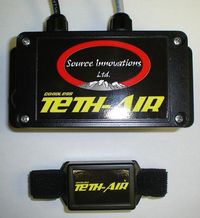If a snowmobiler falls off his vehicle, it can change from a fun recreational machine into a serious and potentially deadly hazard. That’s because even though the driver is no longer actively engaging the throttle, the engine will continue to idle and, if the clutch remains engaged and the vehicle is headed downhill, it can remain in motion. Or worse, snow and ice may freeze the throttle open and the craft may continue moving at very high speeds.
For added safety, some snowmobilers wear a tether (attached to a band worn on the wrist or a lanyard around the neck) while riding. The other end of the tether is joined to the machine’s ignition switch, if the driver falls or jumps off, this action pulls the tether and the engine is immediately turned off. However, some snowmobilers find these physical tethers restrict their range of motion and therefore choose not to use them, says Christopher Wedge, manager of Source Innovations, a Calgary-based manufacturer of snowmobile accessories. And some riders also worry about unintentionally pulling the tether and disengaging the engine while they are still driving the machine—an unwelcome event when riding up a steep slope. Wedge says SnoWest, a publication for snowmobile enthusiasts, conducted a survey that showed only 20 percent of respondents wear the tethers they own.
Wedge is hoping thatTeth-Air, an RFID-based wireless tether system, will attract that 80 percent who don’t use physical tethers. Source Innovations is introducing Teth-Air to the marketplace this fall, bringing the product to trade shows and advertising it in snowmobile industry magazines and hoping to sell through its limited supply of 500 units this winter, so that it can scale up product and distribution next winter.
Wedge says Teth-Air was four years in the making. The earliest prototypes of the system, which consists of an RFID reader mounted on the snowmobile and an active RFID tag that the rider wears on a strap around the wrist, transmitted signals in the 433 and 900 MHz ranges. But the power levels used to send and receive these RF signals “clearly would not pass FCC and Industry Canada certification,” he says. Plus, the tags had poor battery life of just 12 hours or so.
But last year Wedge started working with RFlogy, a Turkish RFID solutions provider, and within six months the latest iteration of Teth-Air was born. The tag and reader communicate at 2.45 GHz using an air-interface protocol that RFlogy developed. The tag has a battery life of roughly six months, and the user can determine the tag’s read range by altering the length of the reader antenna—with the longest possible range of 30 feet. The product comes with instructions for the user to install the reader to the snowmobile, wiring the device to the vehicles the battery and linking it to the ignition system.
The unit sells for about CAN$200—a price about 10 times that of physical tethers. However, aside from the improved range of motion that Teth-Air provides, it can also be used as an antitheft device because the reader will not allow the ignition to turn over unless it picks up a signal from one of the owner’s tags (up to six tags can be paired with a single reader).
One video posting on YouTube shows the ignition cutting off once the tag is thrown away from the machine, and another video shows a snowmobile’s engine dying once it leaves the reader’s range (which is set to a long distance).
“There are 2.1 million registered snowmobiles in North America,” says Hakki Ceyhan, RFlogy’s technology director. “And the Teth-Air system can be mounted on any manufacturer’s snowmobile.”
If demand for the Teth-Air system proves strong, Wedge says the company may also begin marketing the system for users of Jet Skis and other personal watercraft. The company may also begin marketing it as an antitheft system for organizations that maintain large fleets of cars, such as police departments.


